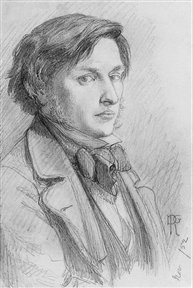
John Everett Millais,
Christ in the House of his Parents,
(“The Carpenter’s Shop”), 1849-1850.
Oil on canvas, 86.4 x 139.7 cm.
Tate Britain, London.
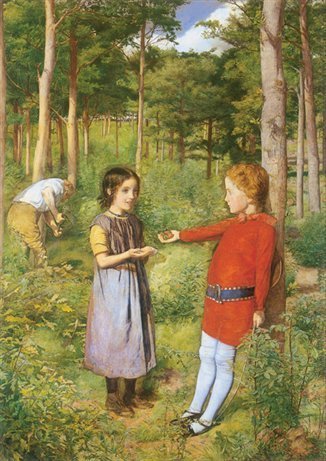
John Everett Millais,
The Woodsman’s Daughter, 1851.
Oil on canvas, 84 x 65 cm.
Guildhall Art Gallery,
Corporation of London, London.
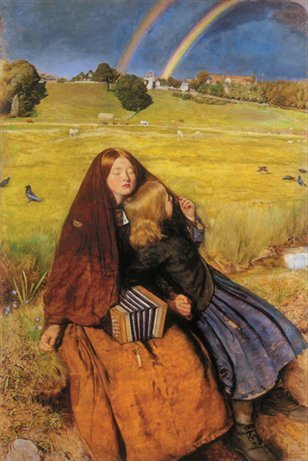
John Everett Millais,
The Blind Girl, 1856.
Oil on canvas, 80.8 x 53.4 cm.
Birmingham Museums & Art Gallery, Birmingham.
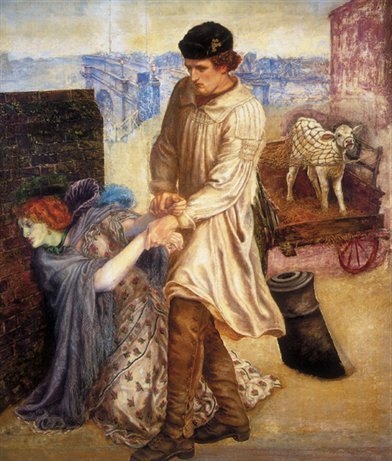
Dante Gabriel Rossetti,
Found, begun in 1869 (unfinished).
Oil on canvas, 76.2 x 88.9 cm.
Samuel and Mary R. Bancroft Collection of
Pre-Raphaelite Art, Delaware Art Museum, Wilmington.
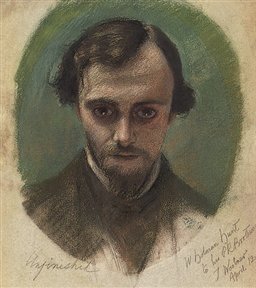
William Holman Hunt,
Dante Gabriel Rossetti, 1853.
Pastel and colour chalk, 28.6 x 25.9 cm.
Manchester Art Gallery, Manchester.
Dante Gabriel Rossetti
(London, 1828 - Birchington, 1882)
The son of an Italian poet, Dante Gabriel Rossetti showed a propensity for painting and drawing very early in his life. Thus, he left school early to begin his apprenticeship. He enrolled in Cary’s Art Academy and was admitted to the Royal Academy Antique School in London around 1846. Except for one trip to Belgium, where he was able to admire the paintings of van Eyck and Memling, Rossetti was far from being an experienced traveller and had not been influenced by other types of painting. He was very impressed by certain works by Ford Madox Brown, and worked under the supervision of this artist, whose remarkable technique helped him acquire the rigour and precision that he had not yet attained. Out of great generosity, Brown took charge of Rossetti’s training without receiving any financial compensation, and had him work in genres such as still-life. It is not surprising that with the help of such a master, as well as that of Millais and Hunt, Rossetti quickly mastered his art. Rossetti’s enthusiasm led him to propose the creation of a “Pre-Raphaelite Brotherhood” along with Hunt and Millais. Though Brown was invited to join them, he refused.
The first of Rossetti’s works as a member of the Pre-Raphaelite Brotherhood was The Childhood of Mary Virgin. This painting, as well as those that followed, received a glacial reception. However, the following year he presented his Ecce Ancilla Domini (The Annunciation) at the exhibition. This is the event that established his reputation. He typically treated subjects related to medieval legend, primitive Italian poetry, and old English ballads. The only notable exception was the painting Found begun around 1852, which was Rossetti’s contribution to the Victorian style that Holman Hunt was particularly fond of. The subject of the painting is a confrontation between a young woman who has given in to the vices of urban life and her former sweetheart, who is appalled to find her in such a state. Rossetti never finished this energetic and moralising painting, which was far removed from his habitual style. In fact, he disapproved of didactic art intended to improve the condition of humanity, and the naturalism that such subjects necessitated. Nevertheless, this painting remains one of his uncontested masterpieces. In 1856, he allied himself with William Morris and Edward Burne-Jones who had the greatest admiration and affection for him.
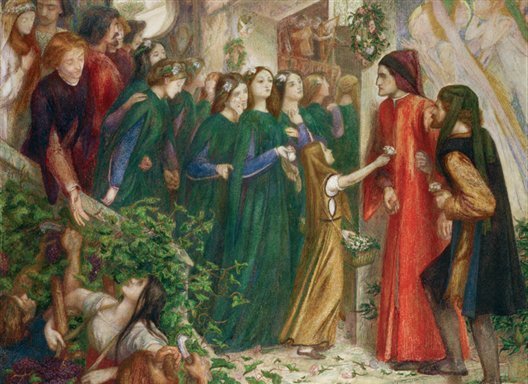
Dante Gabriel Rossetti,
Beatrix Meeting Dante at a Wedding Feast,
Denies him her Salutation, 1855.
Watercolour on paper, 34 x 42 cm.
The Ashmolean Museum of Art and Archaeology,
University of Oxford, Oxford.
Throughout his life, Rossetti was passionate about literature. He began his translation of the thirteenth century Italian Lyrics in 1846, and not long after he published a first version of his remarkable poems, The Blessed Damozel and Sister Helen, which was later revised. In December of 1850 the first issue of The Germ was published. Rossetti held the position of verse and prose poet for this periodical, whose goal was to promote the principles of Pre-Raphaelitism through criticism and examples; each edition was to contain an engraving. The Germ was the collective property of all members of the Brotherhood, but the venture was far from being a financial success and only four issues were published. In 1861 Rossetti actively helped renew taste in stained glass by producing new designs.
In 1860 Rossetti married Elisabeth E. Siddal, who was herself a painter of merit. Mrs Rossetti, whose health was delicate, delivered a stillborn child in 1861 and died the following year from an overdose of laudanum.
Her death overwhelmed Rossetti with sadness, and he buried the manuscript of his poems with her. It was not until 1869 that he disinterred the manuscript, which he published the following year. For the rest of his life, he pursued poetry and painting. Around 1868 he began experiencing insomnia, which deeply disturbed his social life. His circle of friends shrank to only a close few, and he spent much time with William Morris in Kelmscott, Oxfordshire. In 1881 he published Ballads and Sonnets, and he also left us his translation of Dante’s Vita Nueva. In the last years of his life he seemed completely unaware of his growing fame. Unable to sleep without the help of chloral hydrate, he died on 9th April 1882 following health complications.
Both directly with the Pre-Raphaelites and indirectly through the Arts and Crafts movement, Rossetti had considerable influence on numerous areas and left his mark on the poetic technique of his day. Combining Italian sensuality and love of form with the dreamy imagination of more northerly regions, the unique universe of this artist still fascinates us today through his writings and paintings.
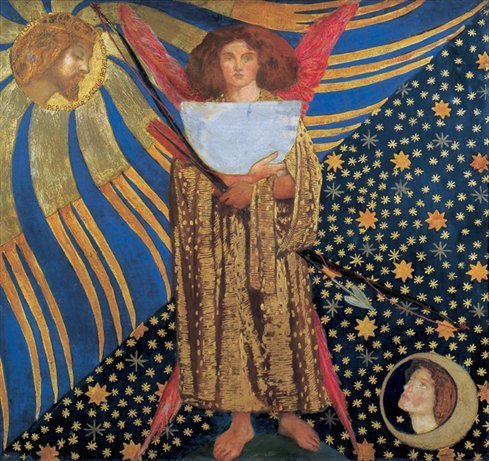
Dante Gabriel Rossetti,
Dantis Amor, 1860.
Oil on mahogany, 74.9 x 81.3 cm.
Tate Gallery, London.
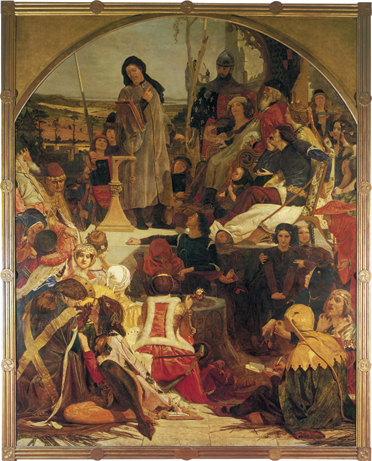
Ford Madox Brown,
Chaucer at the Court of Edward III , 1847-1851.
Oil on canvas, 372 x 296 cm.
Art Gallery of New South Wales, Sydney.
